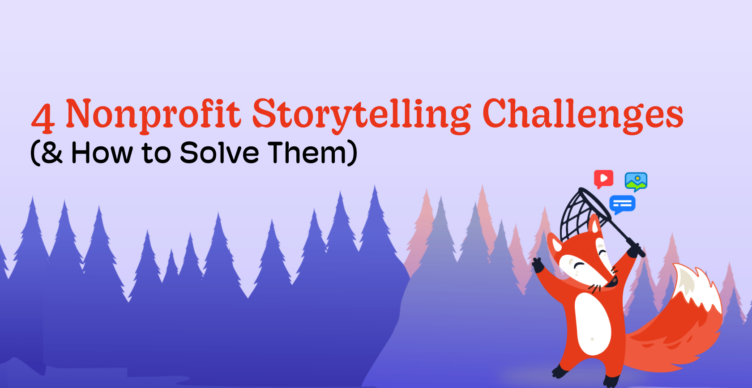Fundraising Tips, Storytelling Strategy
6 Reasons to Inject Storytelling into Your Capital Campaigns
Capital campaigns play a crucial role in raising funds for important projects and initiatives for nonprofits. However, attracting donations can be a challenging endeavor. While the traditional strategy of sharing impact numbers remains effective, a powerful tool that nonprofits can leverage to humanize those numbers, and subsequently increase donations, is storytelling.
But first, what exactly IS a capital campaign? According to our friends at Capital Campaign Pro: 
“Capital campaigns are intense fundraising efforts designed to raise a specific amount of money within a defined time period to build an organization’s assets and capacity. They typically raise much more than an organization has ever raised in a single campaign.“
If your organization is considering launching a capital campaign, we urge you to include heartfelt impact stories from your nonprofit’s community as part of your implementation strategy. Storytelling has the unique ability to connect donors on an emotional level, helping them understand the impact of their contributions and inspiring them to support a cause. In this article, we will explore 6 reasons storytelling will boost the donations to your next capital campaign.
-
- Evoking Emotion: Storytelling taps into the power of emotion, allowing nonprofits to create narratives that resonate with potential donors. By sharing authentic stories from individuals or communities impacted by the nonprofit’s work, organizations can generate empathy and compassion, which compels donors to take action. Personal anecdotes, heartfelt testimonials, and specific case studies bring the campaign to life, making it relatable and inspiring to donors.
-
- Creating a Compelling Narrative: A compelling narrative is essential for capturing attention and maintaining engagement. Organizations should craft a story that highlights the purpose and urgency of their capital campaign. By communicating a clear vision and emphasizing the need for financial support, nonprofits can empower potential donors to become part of the narrative. To create a compelling narrative, organizations must ask the right questions. Check out our 20 Storytelling Interview Questions to get started asking the right questions.
-
- Transparency and Accountability: Transparency is crucial in establishing trust with donors. Nonprofits must provide transparent information about the capital campaign, including the desired outcomes, budget breakdown, and how funds will be utilized. When sharing these details, storytelling techniques can be employed to illustrate the journey from inception to completion, showcasing the impact of each step along the way. Donors appreciate knowing how their contributions will make a difference, and transparency enhances their confidence in the organization, increasing the likelihood of their support.
-
- Engaging Multi-Channel Communication: Nonprofits should leverage several communication channels to distribute captivating stories that capture the attention of diverse audiences. Storytelling, particularly video storytelling, can be effectively conveyed through various channels, such as social media, email, and websites. In fact, social media platforms prioritize video over all other types of content – meaning that your nonprofit video will reach more of your current supporters and new prospects simply by being in video form. If creating video content feels like a big hurdle to jump for your organization, we encourage you to start by using templates. Access our free 12 Months of Gratitude Canva Templates to get started making great content.
-
- Personalized Connections: Individuals are more likely to donate when they feel personally connected to a cause, and let’s face it – it’s very hard to feel connected to an impact number. Sharing personal, authentic stories humanizes the campaign, making it relatable and inspiring others to contribute. Donors are more likely to feel a sense of ownership and pride in supporting a cause that aligns with their personal values and experiences.
-
- Showcasing Tangible Results: Donors want to see tangible results and understand the impact of their contributions. Nonprofits should utilize storytelling to share success stories, milestones, and progress updates related to the capital campaign. This provides a sense of achievement and reinforces the belief that their donations are making a significant difference. Sharing these stories of success encourages ongoing support and motivates donors to remain engaged with the organization’s future endeavors.
 In conclusion, nonprofit storytelling has the power to elevate your next capital campaigns. In a world saturated with information and competing causes, captivating stories have the ability to cut through the noise and resonate with individuals who are looking to make a positive impact.
In conclusion, nonprofit storytelling has the power to elevate your next capital campaigns. In a world saturated with information and competing causes, captivating stories have the ability to cut through the noise and resonate with individuals who are looking to make a positive impact.
Embracing storytelling as a central strategy will not only elevate fundraising efforts for your next capital campaign, but also deepen the connection between nonprofits and their supporters, creating a lasting and mutually beneficial relationship.

About the Author
Carly Euler
Marketing Manager, MemoryFox
Carly comes from the nonprofit world ready to elevate the hundreds of nonprofits in the MemoryFox community. She currently serves as the Co-Chair of the Wily Network’s Young Professionals Association, and has previously held positions at the Breast Cancer Coalition of Rochester, the Code of Support Foundation, Kenya Lacrosse Association, and the BOMA Project, where she has specialized in marketing, communications, and fundraising. Storytelling has been an integral part of each role.




